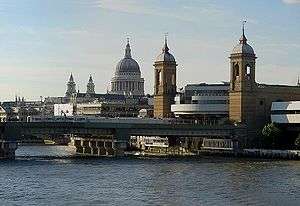Cannon Street station rail crash
 | |
| Date | 8 January 1991 |
|---|---|
| Location | Cannon Street station |
| Country | England |
| Operator | Network SouthEast |
| Cause | Driver error |
| Statistics | |
| Trains | 1 |
| Passengers | 832+[1] |
| Deaths | 2 |
| Injuries | 542 |
| List of UK rail accidents by year | |
The Cannon Street station rail crash was an accident on the British railway system which occurred on 8 January 1991 at Cannon Street station. The accident killed two people and injured 542 others. The 08:44-arriving commuter train failed to stop at Platform 3 of the terminus (colliding with its buffer stop) at around 10 mph.
Accident
The train, composed of 10 cars of elderly Class 415 and Class 416 units started its stopping service at Sevenoaks at 07:58 having passed through London Bridge and still had approximately 1000 passengers on board when it collided with the buffer stop at 08:44 at the Cannon Street terminus within the City of London. The fifth and sixth carriages crushed into each other, one lifting from the tracks. A 24-year-old man was cut free from wreckage crushing his head and abdomen and died from a heart attack on the way to hospital. A 59-year-old female passenger died three days later from injuries sustained. Just over half, 542 other passengers were injured, exacerbated as many of the seated passengers had stood up ready to depart. The later inquiry put the speed at impact at around 10 mph, with earlier rail operator's estimates being lower.[2][1] [3]
Inquiry
A report was compiled of the accident by Her Majesty's Railway Inspectorate.[1] No fault in the train's braking system could be found and the driver, Maurice Graham, was held to blame.[2] He was not tested for drugs until three days after the accident, whereupon traces of cannabis were found in his system. The public inquiry found that there was insufficient evidence to prove drug use had caused the accident.
The inquiry found that the cause of the accident was solely that of driver error. The report also made the following observations:
- The age of the elderly trains increased the effect of the impact. Of the two coaches that suffered the worst damage, one was built on an underbody dating from 1934, having been refitted with a new body in 1953 and involved in a previous collision with a locomotive in 1958; the other was built on an underframe from 1928.
- The interior design of the coaches' fittings and the large number of slam doors could have resulted in weaknesses in the structure of the rolling stock.
- More research is needed on the effect of impacts on passengers, particularly standing passengers, on board commuter trains.
- Automatic Train Protection, or ATP, should be installed as quickly as practicably possible.
- On-train data recorders would make the finding of evidence easier following railway accidents.
- Legislation should be introduced to make it an offence for railway staff with safety responsibilities to be intoxicated while on duty. (The main cause of the Eltham Well Hall rail crash).
- Sliding buffer stops might have minimised the injury compared to the hydraulic buffer stops in this incident.
- Arrangements for the booking-on of staff should be reviewed (a recommendation also made in the report for the Eltham Well Hall rail crash).
References
- 1 2 3 HMRI Report (PDF), from The Railways Archive
- 1 2 BBC Article
- ↑ Event Summary, railwaysarchive.co.uk
External links
- Accident at Cannon Street on 8 January 1991
- A Report of the Collision that occurred on 8 January 1991 at Cannon Street Station (1.1 MB)
Coordinates: 51°30′38″N 0°5′26″W / 51.51056°N 0.09056°W